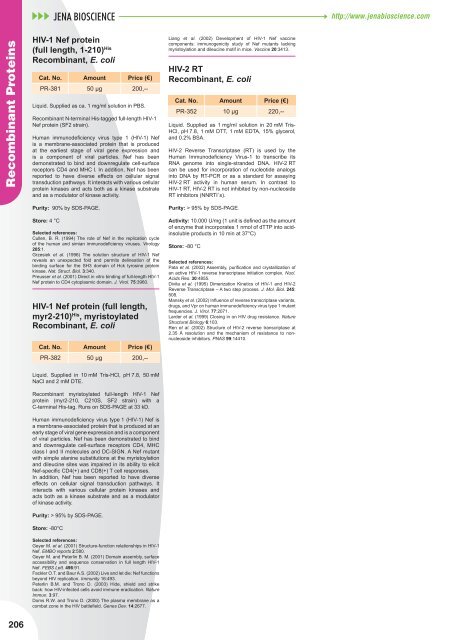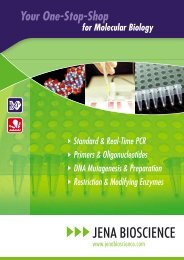Nucleotide Analogs - Jena Bioscience
Nucleotide Analogs - Jena Bioscience
Nucleotide Analogs - Jena Bioscience
You also want an ePaper? Increase the reach of your titles
YUMPU automatically turns print PDFs into web optimized ePapers that Google loves.
Recombinant Proteins<br />
206<br />
HIV-1 Nef protein<br />
(full length, 1-210) His<br />
Recombinant, E. coli<br />
Cat. No. Amount Price (€)<br />
PR-381 50 µg 200,--<br />
Liquid. Supplied as ca. 1 mg/ml solution in PBS.<br />
Recombinant N-terminal His-tagged full-length HIV-1<br />
Nef protein (SF2 strain).<br />
Human immunodefi ciency virus type 1 (HIV-1) Nef<br />
is a membrane-associated protein that is produced<br />
at the earliest stage of viral gene expression and<br />
is a component of viral particles. Nef has been<br />
demonstrated to bind and downregulate cell-surface<br />
receptors CD4 and MHC I. In addition, Nef has been<br />
reported to have diverse effects on cellular signal<br />
transduction pathways. It interacts with various cellular<br />
protein kinases and acts both as a kinase substrate<br />
and as a modulator of kinase activity.<br />
Purity: 90% by SDS-PAGE.<br />
Store: 4 °C<br />
Selected references:<br />
Cullen, B. R. (1994) The role of Nef in the replication cycle<br />
of the human and simian immunodefi ciency viruses. Virology<br />
205:1.<br />
Grzesiek et al. (1996) The solution structure of HIV-1 Nef<br />
reveals an unexpected fold and permits delineation of the<br />
binding surface for the SH3 domain of Hck tyrosine protein<br />
kinase. Nat. Struct. Biol. 3:340.<br />
Preusser et al. (2001) Direct in vitro binding of full-length HIV-1<br />
Nef protein to CD4 cytoplasmic domain. J. Virol. 75:3960.<br />
HIV-1 Nef protein (full length,<br />
myr2-210) His , myristoylated<br />
Recombinant, E. coli<br />
Cat. No. Amount Price (€)<br />
PR-382 50 µg 200,--<br />
Liquid. Supplied in 10 mM Tris-HCl, pH 7.8, 50 mM<br />
NaCl and 2 mM DTE.<br />
Recombinant myristoylated full-length HIV-1 Nef<br />
protein (myr2-210, C210S, SF2 strain) with a<br />
C-terminal His-tag. Runs on SDS-PAGE at 33 kD.<br />
Human immunodefi ciency virus type 1 (HIV-1) Nef is<br />
a membrane-associated protein that is produced at an<br />
early stage of viral gene expression and is a component<br />
of viral particles. Nef has been demonstrated to bind<br />
and downregulate cell-surface receptors CD4, MHC<br />
class I and II molecules and DC-SIGN. A Nef mutant<br />
with simple alanine substitutions at the myristoylation<br />
and dileucine sites was impaired in its ability to elicit<br />
Nef-specifi c CD4(+) and CD8(+) T cell responses.<br />
In addition, Nef has been reported to have diverse<br />
effects on cellular signal transduction pathways. It<br />
interacts with various cellular protein kinases and<br />
acts both as a kinase substrate and as a modulator<br />
of kinase activity.<br />
Purity: > 95% by SDS-PAGE.<br />
Store: -80°C<br />
Selected references:<br />
Geyer M. et al. (2001) Structure-function relationships in HIV-1<br />
Nef. EMBO reports 2:580.<br />
Geyer M. and Peterlin B. M. (2001) Domain assembly, surface<br />
accessibility and sequence conservation in full length HIV-1<br />
Nef. FEBS Lett. 496:91.<br />
Fackler O.T. and Baur A.S. (2002) Live and let die: Nef functions<br />
beyond HIV replication. Immunity 16:493.<br />
Peterlin B.M. and Trono D. (2003) Hide, shield and strike<br />
back: how HIV-infected cells avoid immune eradication. Nature<br />
Immun. 3:97.<br />
Doms R.W. and Trono D. (2000) The plasma membrane as a<br />
combat zone in the HIV battlefi eld. Genes Dev. 14:2677.<br />
Liang et al. (2002) Development of HIV-1 Nef vaccine<br />
components: immunogenicity study of Nef mutants lacking<br />
myristoylation and dileucine motif in mice. Vaccine 20:3413.<br />
HIV-2 RT<br />
Recombinant, E. coli<br />
Cat. No. Amount Price (€)<br />
PR-352 10 µg 220,--<br />
Liquid. Supplied as 1 mg/ml solution in 20 mM Tris-<br />
HCl, pH 7.8, 1 mM DTT, 1 mM EDTA, 15% glycerol,<br />
and 0.2% BSA.<br />
HIV-2 Reverse Transcriptase (RT) is used by the<br />
Human Immunodefi ciency Virus-1 to transcribe its<br />
RNA genome into single-stranded DNA. HIV-2 RT<br />
can be used for incorporation of nucleotide analogs<br />
into DNA by RT-PCR or as a standard for assaying<br />
HIV-2 RT activity in human serum. In contrast to<br />
HIV-1 RT, HIV-2 RT is not inhibited by non-nucleoside<br />
RT inhibitors (NNRTI´s).<br />
Purity: > 95% by SDS-PAGE.<br />
Activity: 10.000 U/mg (1 unit is defi ned as the amount<br />
of enzyme that incorporates 1 nmol of dTTP into acidinsoluble<br />
products in 10 min at 37°C)<br />
Store: -80 °C<br />
Selected references:<br />
Pata et al. (2002) Assembly, purifi cation and crystallization of<br />
an active HIV-1 reverse transcriptase initiation complex. Nucl.<br />
Acids Res. 30:4855.<br />
Divita et al. (1995) Dimerization Kinetics of HIV-1 and HIV-2<br />
Reverse Transcriptase – A two step process. J. Mol. Biol. 245:<br />
508.<br />
Mansky et al. (2002) Infl uence of reverse transcriptase variants,<br />
drugs, and Vpr on human immunodefi ciency virus type 1 mutant<br />
frequencies. J. Virol. 77:2071.<br />
Larder et al. (1999) Closing in on HIV drug resistance. Nature<br />
Structural Biology 6:103.<br />
Ren et al. (2002) Structure of HIV-2 reverse transcriptase at<br />
2.35 Å resolution and the mechanism of resistance to nonnucleoside<br />
inhibitors. PNAS 99:14410.<br />
http://www.jenabioscience.com



